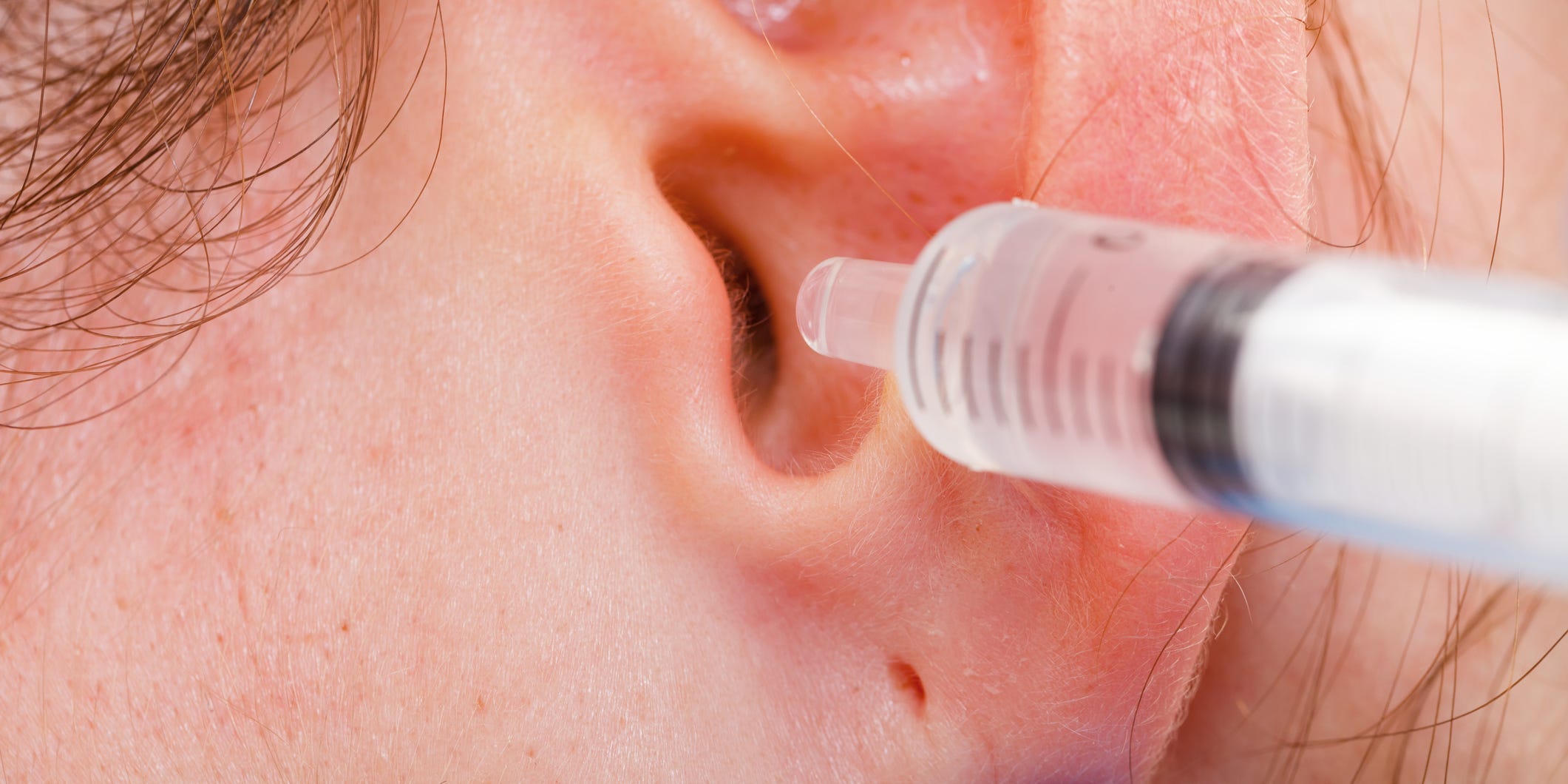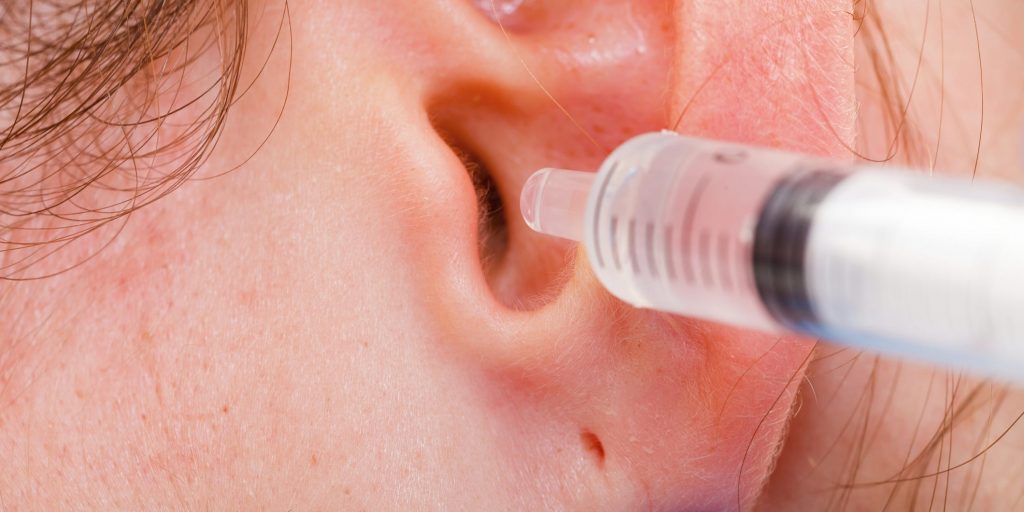
- Try removing ear wax at home with ear drops, or with natural remedies like oils and baking soda.
- Never pick out ear wax with certain objects, including Q-Tips, because it can impact your ear wax.
- If you have impacted ear wax it may need to be treated by a doctor.
- Visit Insider’s Health Reference library for more advice
Ear wax is a fatty substance produced in your ear canal. The wax — medically known as cerumen — cleans your ears, protects them from infection, and lubricates the ear canal to stop it from becoming too dry.
Normally, ear wax will dry up and fall out of your ear over time. However, some people produce more than necessary, and the excess can accumulate in the ear canal and cause buildup or blockage. This is known as impacted ear wax.
Impacted ear wax
Impacted ear wax is a common condition. It affects an estimated:
- 6% of the general population
- 10% of children
- More than 30% of the elderly and cognitively impaired
Impacted ear wax is especially common among the elderly because wax tends to become harder and less mobile, so it’s less likely to work its way out. Hearing aids or earplugs can also prevent extrusion and cause blockage.
Although it’s possible to have impacted ear wax and experience no symptoms, it may cause the following:
- A feeling of fullness in the ear
- Earache
- Difficulty hearing or hearing loss
- Ringing in the ear, known as tinnitus
- A feeling of itchiness in the ear
- Discharge from the ear
- Odor coming from the ear
- Dizziness
If you struggle to hear or repeatedly feel ear pain, you should check in with a doctor, says Jerry Lin, MD, PhD, an ear, nose, and throat specialist at the University of Louisville, who can recommend the best course of treatment for you.
Sometimes, you will have to visit the doctor, who can perform clinical irrigation or manually remove ear wax with a special instrument.
Other times, you can use ear drops to remove ear wax at home. Below are three ways to remove ear wax at home, naturally.
1. Use ear drops
Ear drops are liquid solutions — known scientifically as cerumenolytic agents — which help thin, soften, break up, or dissolve ear wax, so it can leave the ear.
Drops are available over the counter, and common name-brand ear drops include Debrox, Hylands, and Similasan. Typically, it's recommended to use up to five drops at a time, one to two times daily, for three to seven days.
Lin says that ear drops work immediately after use, though they may require a few tries to remove especially stubborn ear wax.
While there is limited published evidence on the effectiveness of drops, one study suggests that using them for five days is more likely to completely clear the excessive wax than no treatment at all.
2. Try oil
There are other ways you can remove ear wax at home with natural substances, though they will likely take longer to work than ear drops.
Oils, such as baby oil, mineral oil, coconut oil, olive oil, or glycerin — a natural compound derived from vegetable oils or animal fats — can be used to soften and remove ear wax.
Here's how to do it:
- Apply the oil. Tilt your head to the side and — using an eyedropper, or dropper bottle — apply a few drops of your oil of choice into the ear canal.
- Drain it out using warm water. After a day or two, when the wax is softened, use a rubber-bulb syringe to gently squirt warm water into your ear canal. Tilt your head and pull your outer ear up and back to straighten your ear canal. When finished irrigating, tip your head to the side to let the water drain out.
- Dry your ear canal. Use either a towel or hair-dryer on low or no heat to gently dry your ear canal. This is optional, according to Lin.
- Repeat, if necessary. You can try this method multiple times every few days until the excess ear wax is removed.
3. Make a baking soda solution
Alternatively, you may also be able to remove ear wax with a baking soda solution:
- Create the baking soda solution. Dissolve half a teaspoon of baking soda in two ounces of warm water. If you have a dropper bottle, pour the solution into it.
- Apply to your ears. Tilt your head to the side, and using an eyedropper or dropper bottle, drop five to ten drops of the solution into your ear.
- Drain it out using warm water. After about an hour or so, when the wax is softened, use a rubber-bulb syringe to gently squirt warm water into your ear canal. Tilt your head and pull your outer ear up and back to straighten your ear canal. When finished irrigating, tip your head to the side to let the water drain out.
- Dry your ear canal. Use either a towel or hair-dryer on low or no heat to gently dry your ear canal. This is optional, according to Lin.
- Repeat, if necessary. You can try this method once a day until the ear wax clears up, but for no longer than two weeks. It can clear up within a couple of days.
It's important to note that these natural softening agents can sometimes have adverse effects, because they may only loosen the outer layer of the wax, which can then lodge deeper into the ear canal.
What not to do when trying to remove ear wax
Trying to manually remove the wax yourself with your finger or other objects can make the blockage worse.
"Picking out wax that is visible just at the entrance into the ear canal is OK," says Lin. "Anything deeper should either be allowed to work its way out on its own or be removed by a physician."
In fact, some blockages can occur when you try to clean your ears with cotton swabs and accidentally push the wax deeper. While Q-Tips are commonly used, they should be avoided.
"Q-Tips are a bad idea," Lin says. "They take up much of the canal diameter. Therefore, using them packs the wax deeper into the ear canal. In the worst-case scenario, the wax could be packed against the eardrum and possibly even create an eardrum perforation."
In addition, you should not attempt home remedies like ear candling, which drip hot wax into your ear and are marketed — incorrectly — as miracle cures. The United States Food and Drug Administration (FDA) strongly recommends against ear candling, as it is both ineffective and dangerous.
Insider's takeaway
While it can feel good to stick things like Q-tips in your ears, you should be very selective about what you put in there. Otherwise, you risk impacting the ear wax, which can lead to uncomfortable symptoms like earache and dizziness.
Instead of a Q-tip try using ear drops, oil, or a baking soda solution to loosen up ear wax and remove it. And if you are suffering from chronic ear pain, it's important to see a doctor for treatment options.
